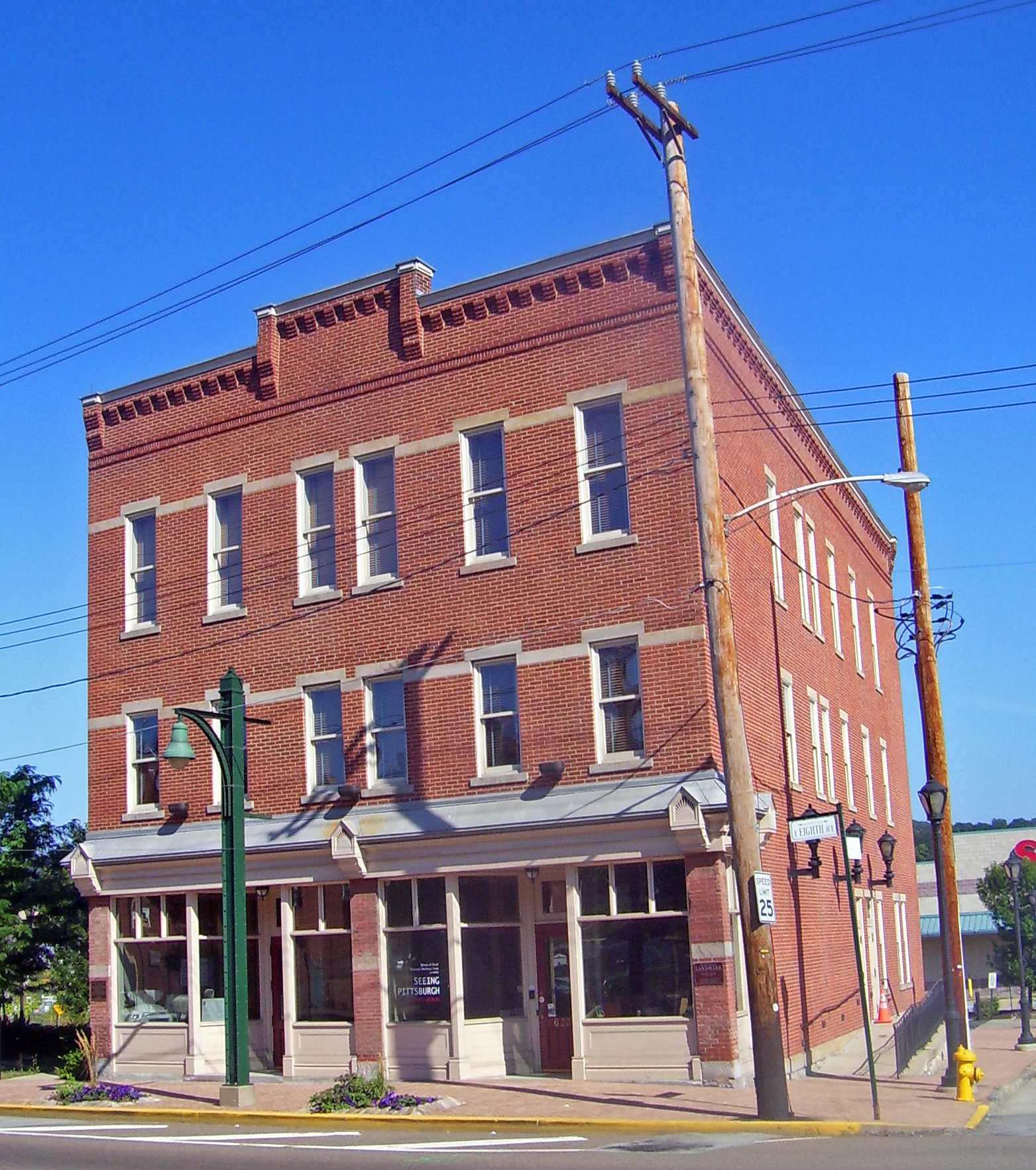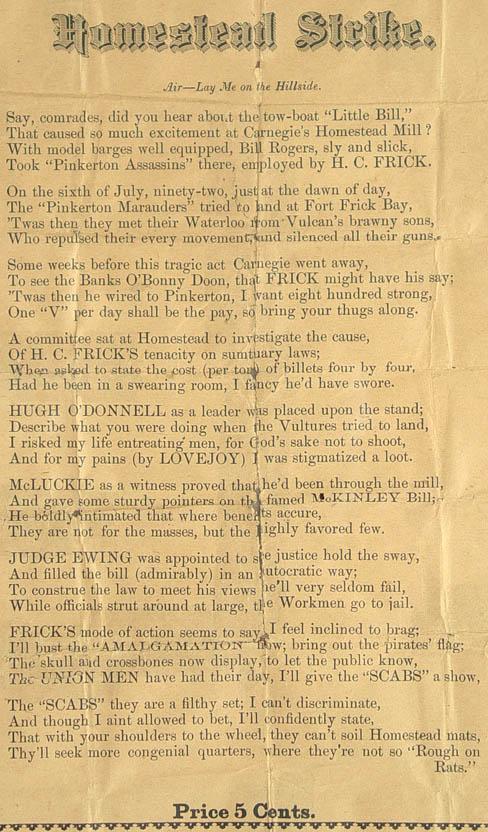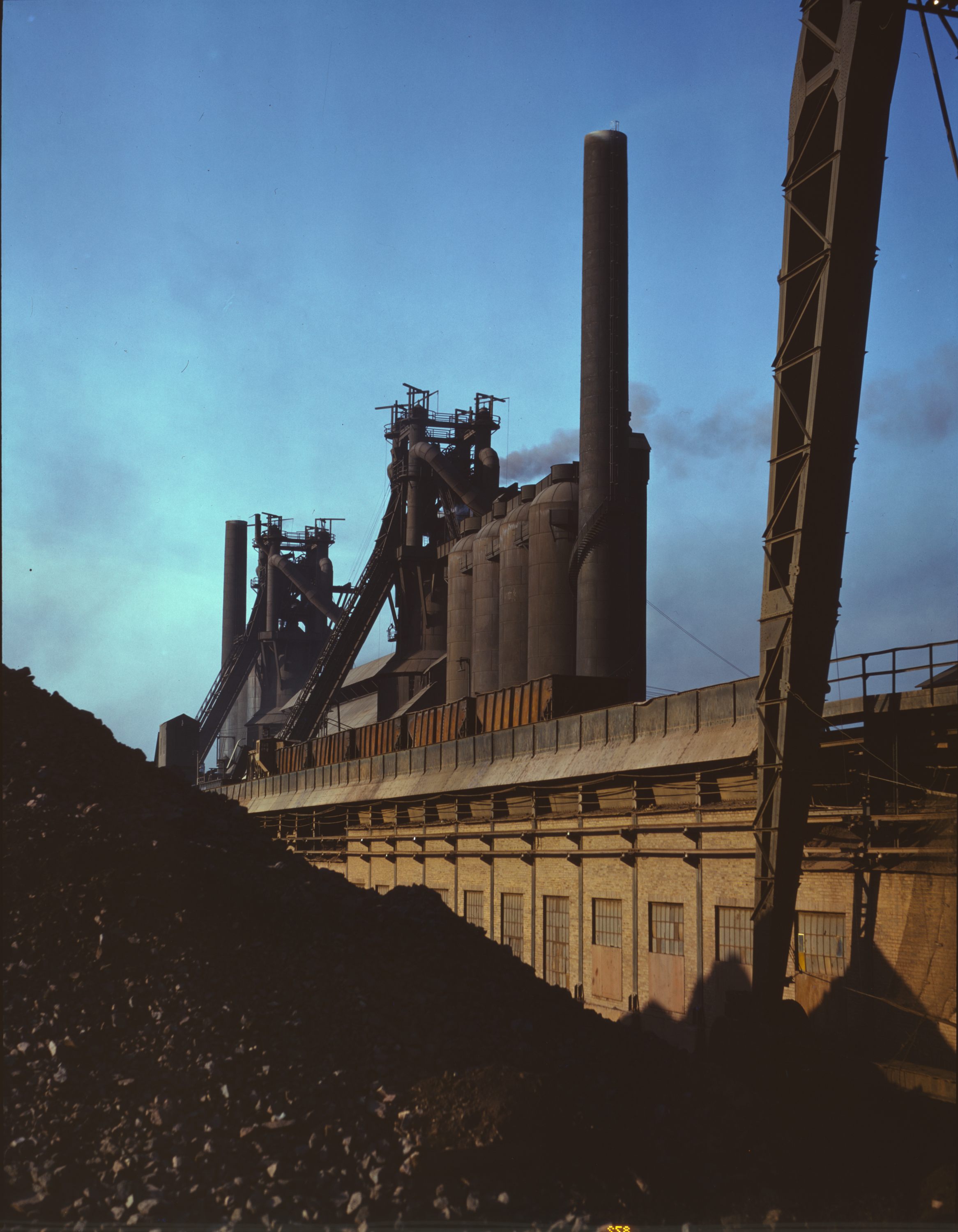|
Homestead Historic District
The Homestead Historic District is a historic district A historic district or heritage district is a section of a city which contains older buildings considered valuable for historical or architectural reasons. In some countries or jurisdictions, historic districts receive legal protection from c ... which is located in Homestead, Munhall, and West Homestead, Pennsylvania. It was listed on the National Register of Historic Places (NRHP) in 1990. History This historic district encompasses the site of the Homestead Strike of 1892, when the Carnegie Steel Company, under the leadership of Henry Clay Frick, broke the Amalgamated Association of Iron and Steel Workers union. This district also includes the Homestead Pennsylvania Railroad Station, which is separately listed on the NRHP, and the Bost Building, a U.S. National Historic Landmark. It is situated close to Pittsburgh. Gallery File:HomesteadPennsylvaniaRailroadStation.jpg, Homestead Pennsylvania Railroa ... [...More Info...] [...Related Items...] OR: [Wikipedia] [Google] [Baidu] |
Bost Building
The Bost Building, also known as Columbia Hotel, is located on East Eighth Avenue ( PA 837) in Homestead, Pennsylvania, United States. Built just before the 1892 Homestead Strike, it was used as headquarters by the Amalgamated Association of Iron and Steel Workers and for reporters covering the confrontation. It is the only significant building associated with the strike that remains intact. It is a contributing property to the Homestead Historic District. It was declared a National Historic Landmark in 1999. After some use as a rooming house and hotel, today it serves as the headquarters and visitor center for the Rivers of Steel National Heritage Area. Museum The museum features displays the area's industrial, social and cultural history. Exhibits include two restored rooms reflecting the 1892 Homestead Strike by the Amalgamated Association of Iron and Steel Workers during the Homestead Lockout and Strike, and a room dedicated to the Homestead Steel Works. Visitors can pick ... [...More Info...] [...Related Items...] OR: [Wikipedia] [Google] [Baidu] |
Amalgamated Association Of Iron And Steel Workers
Amalgamated Association of Iron and Steel Workers (AA) was an American labor union formed in 1876 to represent iron and steel workers. It partnered with the Steel Workers Organizing Committee of the CIO, in November 1935. Both organizations disbanded May 22, 1942, to form a new organization, the United Steelworkers. The Homestead strike The Homestead strike was a major turning point for the union. Andrew Carnegie placed strong anti-unionist Henry Clay Frick in charge of his company's operations in 1881. With the union's contract due to expire on June 30, 1892, Frick demanded a 22 percent wage decrease, then unilaterally announced that if an agreement was not reached he would no longer recognize the union. Frick locked the workers out on June 29. The striking workers ringed the plant and patrolled the Monongahela River (which ran alongside the mill) to prevent anyone from entering. Local sheriff's deputies failed to retake the plant on July 5. Frick then sent 300 Pinkerton ... [...More Info...] [...Related Items...] OR: [Wikipedia] [Google] [Baidu] |
Homestead Strike
The Homestead strike, also known as the Homestead steel strike, Homestead massacre, or Battle of Homestead, was an industrial lockout and strike that began on July 1, 1892, culminating in a battle in which strikers defeated private security agents on July 6, 1892. The governor responded by sending in the National Guard to protect strikebreakers. The dispute occurred at the Homestead Steel Works in the Pittsburgh-area town of Homestead, Pennsylvania, between the Amalgamated Association of Iron and Steel Workers (the AA) and the Carnegie Steel Company. The final result was a major defeat for the union strikers and a setback of decades for their efforts to unionize steelworkers. The battle was a pivotal event in U.S. labor history. Background Carnegie Steel made major technological innovations in the 1880s, especially the installation of the open-hearth system at Homestead in 1886. It now became possible to make steel suitable for structural beams and for armor plate for the Uni ... [...More Info...] [...Related Items...] OR: [Wikipedia] [Google] [Baidu] |
Homestead, Pennsylvania
Homestead is a borough in Allegheny County, Pennsylvania, USA, in the Monongahela River valley southeast of downtown Pittsburgh and directly across the river from the city limit line. The borough is known for the Homestead Strike of 1892, an important event in the history of labor relations in the United States. The population of Homestead was 2,884 at the 2020 census. History The area on the south bank of the Monongahela River now comprising the boroughs of Homestead, Munhall and West Homestead saw the first white settlers arrive in the 1770s. One hundred years later, much of the existing farmland on the flats and hillsides by the river was purchased, laid out in lots and sold by local banks and land owners to create the town of Homestead. The town was chartered in 1880. The building of a railroad, glass factory, and in 1881 the first iron mill began a period of rapid growth and prosperity. In 1883, Andrew Carnegie bought out Homestead Steel Works, adding it to his empire ... [...More Info...] [...Related Items...] OR: [Wikipedia] [Google] [Baidu] |
Munhall, Pennsylvania
Munhall is a borough in Allegheny County, Pennsylvania, United States, on the west bank of the Monongahela River, south of the confluence of the Monongahela and the Allegheny rivers where the Ohio River begins. It abuts the borough of Homestead. A large part of the Homestead Works of the Carnegie Steel Company existed in Munhall. Steel products were the only items made in Munhall in 1910 when 5,185 people lived here. In 1940, 13,900 people lived in Munhall. The population was 11,406 at the 2010 census. Munhall, along with the boroughs of Homestead and West Homestead, is served by the Steel Valley School District. History A post office called Munhall was established in 1887. The borough was formed on June 24, 1901, out of a part of Mifflin Township, and named for John Munhall, the original owner of the town site. Attractions The Homestead Library, located in Munhall, was donated by Andrew Carnegie in 1896. It has been restored and modernized during the last quarter of a ce ... [...More Info...] [...Related Items...] OR: [Wikipedia] [Google] [Baidu] |
West Homestead, Pennsylvania
West Homestead is a borough in Allegheny County, Pennsylvania, southeast of Pittsburgh, on the Monongahela River. Heavy industries associated with nearby steel mills existed here. Established were axle works, brickworks, and manufactories of machinery, car wheels, etc. The largest concern was Mesta Machinery which was one of the world's leading industrial manufacturers from 1898 until 1983. The population was 1,929 at the 2010 census. History There are two primary residential communities in West Homestead: the historic district and the Village, a post-World War II hilltop community. The historic district consists of a series of hillside residential streets adorned by intact worker houses reflecting the architecture of the late nineteenth and early twentieth century period when most of these homes were originally built. Composed of homes perfectly suited for contemporary restoration, this neighborhood has a commanding view of the gorgeous river valley. One of the most notewor ... [...More Info...] [...Related Items...] OR: [Wikipedia] [Google] [Baidu] |
Historic District (United States)
Historic districts in the United States are designated historic districts recognizing a group of buildings, Property, properties, or sites by one of several entities on different levels as historically or architecturally significant. Buildings, structures, objects and sites within a historic district are normally divided into two categories, Contributing property, contributing and non-contributing. Districts vary greatly in size: some have hundreds of structures, while others have just a few. The U.S. federal government designates historic districts through the United States Department of the Interior, United States Department of Interior under the auspices of the National Park Service. Federally designated historic districts are listed on the National Register of Historic Places, but listing usually imposes no restrictions on what property owners may do with a designated property. U.S. state, State-level historic districts may follow similar criteria (no restrictions) or may req ... [...More Info...] [...Related Items...] OR: [Wikipedia] [Google] [Baidu] |
National Register Of Historic Places
The National Register of Historic Places (NRHP) is the United States federal government's official list of districts, sites, buildings, structures and objects deemed worthy of preservation for their historical significance or "great artistic value". A property listed in the National Register, or located within a National Register Historic District, may qualify for tax incentives derived from the total value of expenses incurred in preserving the property. The passage of the National Historic Preservation Act (NHPA) in 1966 established the National Register and the process for adding properties to it. Of the more than one and a half million properties on the National Register, 95,000 are listed individually. The remainder are contributing resources within historic districts. For most of its history, the National Register has been administered by the National Park Service (NPS), an agency within the U.S. Department of the Interior. Its goals are to help property owners and inte ... [...More Info...] [...Related Items...] OR: [Wikipedia] [Google] [Baidu] |
Carnegie Steel Company
Carnegie Steel Company was a steel-producing company primarily created by Andrew Carnegie and several close associates to manage businesses at steel mills in the Pittsburgh, Pennsylvania area in the late 19th century. The company was formed in 1892 and was subsequently sold in 1901 in one of the largest business transactions of the early 20th century, to become the major component of U.S. Steel. The sale made Carnegie one of the richest men in history. Creation Carnegie began the construction of his first steel mill, the Edgar Thomson Steel Works, in 1872 at Braddock, Pennsylvania. The Thomson Steel Works began producing rails in 1874. By a combination of low wages, efficient technology infrastructure investment and an efficient organization, the mill produced cheap steel, which sold for a large profit in the growing markets of industrial development. Carnegie alone estimated that 40% was returned on the investment, i.e., a profit of $40,000 from a $100,000 investment in ... [...More Info...] [...Related Items...] OR: [Wikipedia] [Google] [Baidu] |
Henry Clay Frick
Henry Clay Frick (December 19, 1849 – December 2, 1919) was an American industrialist, financier, and art patron. He founded the H. C. Frick & Company coke manufacturing company, was chairman of the Carnegie Steel Company, and played a major role in the formation of the giant U.S. Steel manufacturing concern. He also financed the construction of the Pennsylvania Railroad and the Reading Company, and had extensive real estate holdings in Pittsburgh and throughout the state of Pennsylvania. He later built the historic neoclassical Frick Mansion (now a landmark building in Manhattan), and upon his death donated his extensive collection of old master paintings and fine furniture to create the celebrated Frick Collection and art museum. However, as a founding member of the South Fork Fishing and Hunting Club, he was also in large part responsible for the alterations to the South Fork Dam that caused its failure, leading to the catastrophic Johnstown Flood. His vehement oppositi ... [...More Info...] [...Related Items...] OR: [Wikipedia] [Google] [Baidu] |
Homestead Pennsylvania Railroad Station
Homestead is a former railway station which is located in Homestead, Pennsylvania. It is now used by the Allegheny County District Attorney's office as a support and training facility. History and architectural features Built in 1906 by the Pennsylvania Railroad, this station was added to the National Register of Historic Places on December 26, 1985, as the Homestead Pennsylvania Railroad Station. Currently, the station is used by Allegheny County District Attorney's Office as its Regional Support and Training Center at the Waterfront. See also *National Register of Historic Places listings in Allegheny County, Pennsylvania __NOTOC__ This is a list of the National Register of Historic Places listings in Allegheny County, Pennsylvania. This is intended to be a complete list of the properties and districts on National Register of Historic Places in Allegheny County, ... References External links Homestead Train Whistle Ringtone ''Locally Toned'' {{National Register of Hi ... [...More Info...] [...Related Items...] OR: [Wikipedia] [Google] [Baidu] |
Pittsburgh, Pennsylvania
Pittsburgh ( ) is a city in the Commonwealth (U.S. state), Commonwealth of Pennsylvania, United States, and the county seat of Allegheny County, Pennsylvania, Allegheny County. It is the most populous city in both Allegheny County and Western Pennsylvania, the List of municipalities in Pennsylvania#Municipalities, second-most populous city in Pennsylvania behind Philadelphia, and the List of United States cities by population, 68th-largest city in the U.S. with a population of 302,971 as of the 2020 United States census, 2020 census. The city anchors the Pittsburgh metropolitan area of Western Pennsylvania; its population of 2.37 million is the largest in both the Ohio Valley and Appalachia, the Pennsylvania metropolitan areas, second-largest in Pennsylvania, and the List of metropolitan statistical areas, 27th-largest in the U.S. It is the principal city of the greater Pittsburgh–New Castle–Weirton combined statistical area that extends into Ohio and West Virginia. Pitts ... [...More Info...] [...Related Items...] OR: [Wikipedia] [Google] [Baidu] |






